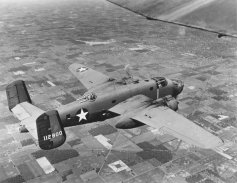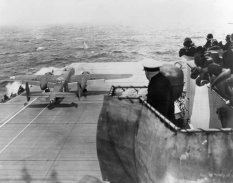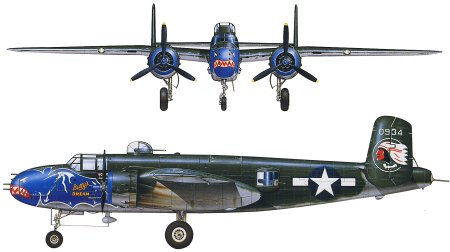
Home »
USA » North American B-25 Mitchell
North American B-25 Mitchell
Rushing in at low level with guns blazing, this twin-engine medium bomber was the most fearsome sight of World War II. The North AmericanB-25 Mitchell sent bombs screaming earthward from high in the sky, but it also attacked with speed and surprise down on the deck, strafing ships and troops with its lethal nose guns. The B-25 was a hard-hitter a superb weapon and a great aircraft.
The first bomber from North American the graceful and deadly B-25 was named after the outspoken champion of US air power, General 'Billy' Mitchell. The B-25 is best remembered for the April 1942 bombing of Tokyo led by Lieutenant Colonel James Doolittle, which was launched from the carrier Hornet. At the time, the Allies were being defeated in the Pacific and this first strike on Japanese soil boosted American morale.
The Mitchell bomber fought all over the world. Pilots praised its speed, brute strength and quick control response. Some Mitchells carried nose 75 mm (2.95 in) cannons to increase their firepower during low-level raids on Japanese shipping.
Mitchells flew with the Marines in tough Pacific fighting and were called PBJs. The B-25 also flew with a dozen other nations in Russia, North Africa and throughout Europe. It was frightening to be on the receiving end of a B-25 attack but to the Allies the aircraft was a great warrior and a triumph of weaponry.
 |
 |
 |
| When the USAAF realised that most B-25 missions were at low level, they took out the bombardier and replaced him with a battery of guns in the nose and on the fuselage sides. |
The B-25's best-known exploit was the daring raid in April 1942 when Lt Col Jimmy Doolittle led 16 Mitchells from the deck of USS Hornet on the first strike against the Japanese mainland. |
This B-25 carries the rousing legend 'Finito Benito, next Hirohito' along its wings - a reference to the defeat of the Italian dictator and the anticipated battle for Japan. |
|
North American B-25 Mitchell (Technical Specification) |
| Role |
Five-seat medium bomber |
| Manufacturer |
North American |
| Maximum Speed |
438 kmh (240 mph) |
| Maximum range |
2,200 km (1,300 miles) |
| Ceiling |
7,375 meters (23,800 feet) |
Weight
Empty
Maximum Takeoff |
8,836 kg (19,400 lbs)
15,876 kg (36,000 lbs) |
Dimensions
Wingspan
Length
Height
Wing Area |
20.60 meters (67 ft 7 in)
16.13 meters (51 ft)
4.98 meters (15 ft 9 in)
56.67 square meters (610 sq ft) |
| Engines |
Two Wright R-2600-92 Cyclone 14-cylinder radial piston engines each providing 1268-kW (1,700 hp) |
| Armament |
One 75 mm (2.95 in) cannon
16X12.7 mm (0.50 cal) machine-guns
Eight 127 mm (5 in) rocket projectiles
1360 kgs (3,000 lbs) of bombs |
Photo Gallery
Click here to submit your photo
| Have A Passion For Aircraft? |
Subscribe to our 14 series FREE newsletter
delivered weekly on World War 2 Aircraft factfile... |
| NB:- We hate spam as much as you do, so your email address will NEVER be shared with or sold to anyone else. That's a Guarantee. |
|
|





